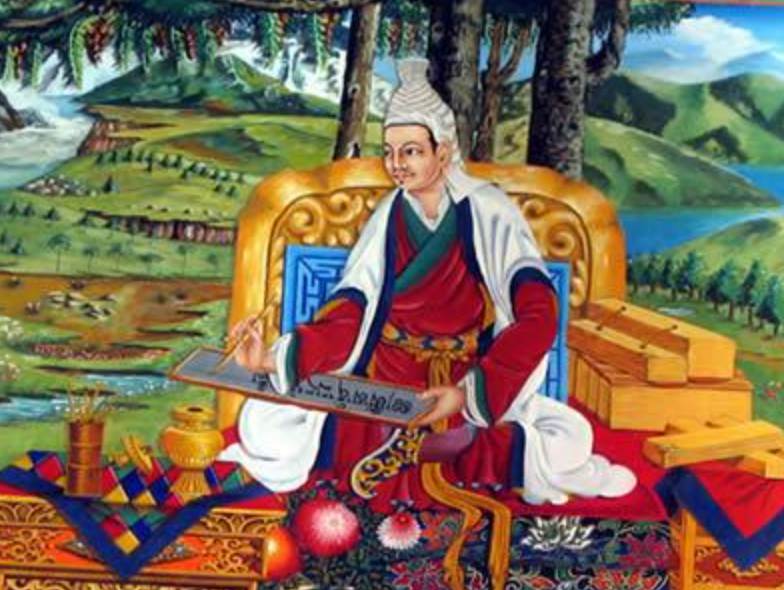The Life & Legacy of Tonmi Sambhota
Introduction
Thonmi Sambhota is a monumental figure in Tibetan history, celebrated as the creator of the Tibetan script and as a pivotal figure in the development of Tibetan literature and culture. His contributions to the written language of Tibet have had a profound and lasting impact, enabling the preservation and transmission of Tibetan Buddhist teachings and other aspects of Tibetan heritage. This essay explores the life of Thonmi Sambhota, his achievements, and the historical context in which he worked.
Early Life and Background
Thonmi Sambhota, also known as Thönmi Sambhota, was born in the early 7th century during the reign of King Songtsen Gampo (reigned 618–649 CE), one of Tibet’s most revered and influential monarchs. His exact birth date is not well-documented, but he is believed to have been born in the region of Tsang, in central Tibet.
Little is known about his early life, but Thonmi Sambhota was recognized for his exceptional intelligence and scholarly potential from a young age. It is said that he was among a group of bright young men selected by King Songtsen Gampo to be sent to India to study and bring back knowledge that could be used to develop a written script for the Tibetan language. This initiative was part of the king’s broader efforts to strengthen and modernize the Tibetan state through cultural and administrative reforms.
Journey to India
The journey to India was a significant undertaking during the 7th century, requiring determination and resilience. Thonmi Sambhota and his companions traveled to the renowned centers of learning in India, particularly to the region of Magadha, which was a major hub of Buddhist scholarship. In Magadha, Thonmi Sambhota studied under eminent scholars and monks, gaining deep insights into the Sanskrit language and script, as well as the principles of grammar and writing.
During his time in India, Thonmi Sambhota became proficient in Sanskrit and familiarized himself with the Devanagari script, which was one of the scripts used for writing Sanskrit. This knowledge was crucial for his later work in developing the Tibetan script.
Creation of the Tibetan Script
Upon his return to Tibet, Thonmi Sambhota undertook the monumental task of creating a written script for the Tibetan language. This task was not merely about devising a set of characters; it also involved developing a comprehensive system of grammar and orthography that could accurately represent the sounds and structure of the Tibetan language.
Drawing upon his knowledge of Sanskrit and the Devanagari script, Thonmi Sambhota created the Tibetan script, which is fundamentally an alphabetic system. The script he devised consists of thirty consonantal characters and four vowel diacritics. This system allowed for the precise representation of Tibetan phonetics and facilitated the accurate transcription of oral teachings and texts.
In addition to the script itself, Thonmi Sambhota also composed a set of grammatical treatises, collectively known as the “Sumchupa” and “Rtags kyi ‘jug pa.” These works laid the foundation for Tibetan grammar and orthography, providing rules and guidelines for the use of the script. The “Sumchupa,” for example, is a treatise on grammar that elucidates the principles of Tibetan syntax, morphology, and phonology.
Impact on Tibetan Culture and Buddhism
The creation of the Tibetan script had a profound and far-reaching impact on Tibetan culture and society. One of the most significant outcomes was the ability to transcribe and preserve Buddhist scriptures and teachings. Prior to the advent of the written script, these teachings were transmitted orally, which posed challenges for their preservation and accurate transmission.
With a written script, Tibetan scholars and monks were able to translate a vast corpus of Buddhist texts from Sanskrit into Tibetan. This translation effort, which began in earnest during the reign of King Songtsen Gampo and continued for several centuries, played a crucial role in the establishment and flourishing of Buddhism in Tibet. The Tibetan script enabled the compilation of extensive canonical collections, such as the Kangyur (the translated words of the Buddha) and the Tengyur (the translated commentaries), which remain central to Tibetan Buddhism to this day.
Beyond its religious significance, the Tibetan script also facilitated the development of secular literature, historical records, legal documents, and administrative texts. This contributed to the consolidation of the Tibetan state and the establishment of a literate and educated elite capable of governing and administering the kingdom effectively.
Legacy and Historical Significance
Thonmi Sambhota’s contributions have ensured his lasting legacy in Tibetan history. His creation of the Tibetan script and grammatical system is considered one of the most important cultural achievements in Tibetan history. This script has remained in continuous use for over a millennium, serving as the medium for the preservation and transmission of Tibetan culture, religion, and knowledge.
Moreover, Thonmi Sambhota is venerated as a cultural hero and a saint in Tibetan tradition. He is often depicted in religious art and iconography, and his life and achievements are celebrated in Tibetan literature and folklore. His legacy is not limited to Tibet; the Tibetan script he developed has also influenced other scripts in the Himalayan region, such as those used in Bhutan and parts of Nepal.
Historical Context and Significance of King Songtsen Gampo's Reign
To fully appreciate the significance of Thonmi Sambhota’s work, it is essential to understand the broader historical context of King Songtsen Gampo’s reign. Songtsen Gampo is regarded as one of Tibet’s most important historical figures, and his reign marked a period of significant political and cultural transformation.
Songtsen Gampo is credited with unifying the various Tibetan tribes and establishing the Tibetan Empire as a formidable political entity. He implemented a series of reforms aimed at modernizing the state and consolidating his power. These reforms included the establishment of a centralized administrative system, the construction of monumental architecture (such as the Jokhang Temple in Lhasa), and the promotion of Buddhism as a unifying cultural and spiritual force.
One of Songtsen Gampo’s key strategies for achieving these goals was the adoption and adaptation of foreign knowledge and technologies. This included sending envoys and scholars to neighboring civilizations, such as China and India, to learn from their advanced cultures. Thonmi Sambhota’s mission to India and his subsequent creation of the Tibetan script can be seen as part of this broader initiative.
The Translation Movement and the Spread of Buddhism
The creation of the Tibetan script by Thonmi Sambhota set the stage for one of the most significant intellectual and religious movements in Tibetan history: the translation of Buddhist texts. This translation movement, which began in earnest during the 7th century and continued for several centuries, was instrumental in the establishment of Buddhism as the dominant religion in Tibet.
Tibetan translators, often working in collaboration with Indian scholars, translated an immense body of Buddhist literature from Sanskrit (and sometimes from other languages such as Pali and Chinese) into Tibetan. This effort was not only a linguistic endeavor but also a profound act of cultural and religious synthesis. The translators had to navigate complex philosophical concepts and ensure that these ideas were accurately conveyed in the Tibetan language.
The success of this translation movement was made possible by the script and grammatical framework developed by Thonmi Sambhota. His work provided the tools necessary for the precise and systematic translation of intricate texts, ensuring that the teachings of the Buddha could be faithfully preserved and disseminated throughout Tibet.
Thonmi Sambhota's Role in Tibetan Identity
Thonmi Sambhota’s contributions extend beyond the realm of linguistics and religion; they also played a crucial role in shaping Tibetan national and cultural identity. The creation of a written language is a defining moment in the history of any civilization, and for Tibet, it marked the emergence of a literate society with a distinct cultural heritage.
The Tibetan script became a symbol of Tibetan identity and autonomy. It distinguished Tibetan culture from its neighbors and provided a means of preserving and transmitting Tibetan traditions, values, and beliefs. In times of political upheaval and foreign domination, the Tibetan script and the literature it enabled have served as a source of resilience and continuity for the Tibetan people.
Conclusion
Thonmi Sambhota’s life and work stand as a testament to the transformative power of knowledge and cultural exchange. His creation of the Tibetan script was a monumental achievement that facilitated the preservation and flourishing of Tibetan Buddhism, literature, and culture. It enabled the translation of vast Buddhist canonical texts, contributing to the spiritual and intellectual enrichment of Tibetan society.
Through his pioneering efforts, Thonmi Sambhota has left an indelible mark on Tibetan history. His legacy continues to be celebrated and revered, not only in Tibet but also in the broader Himalayan region. As a scholar, linguist, and cultural hero, Thonmi Sambhota’s contributions exemplify the enduring importance of language in shaping the identity and heritage of a people. His work underscores the profound impact that a single individual can have on the cultural and intellectual development of a society, securing his place as one of Tibet’s most illustrious historical figures.

